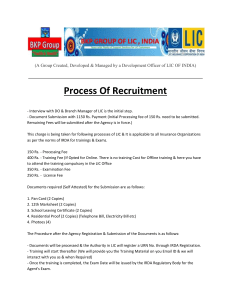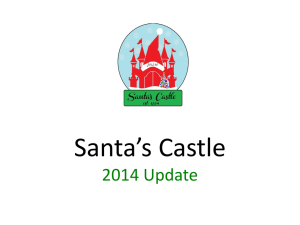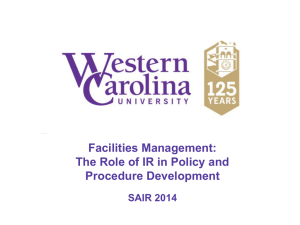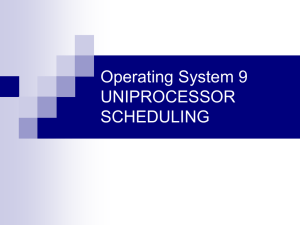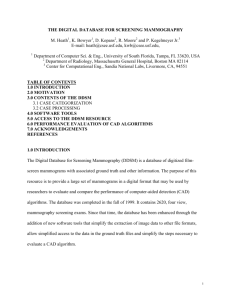PowerPoint File
advertisement
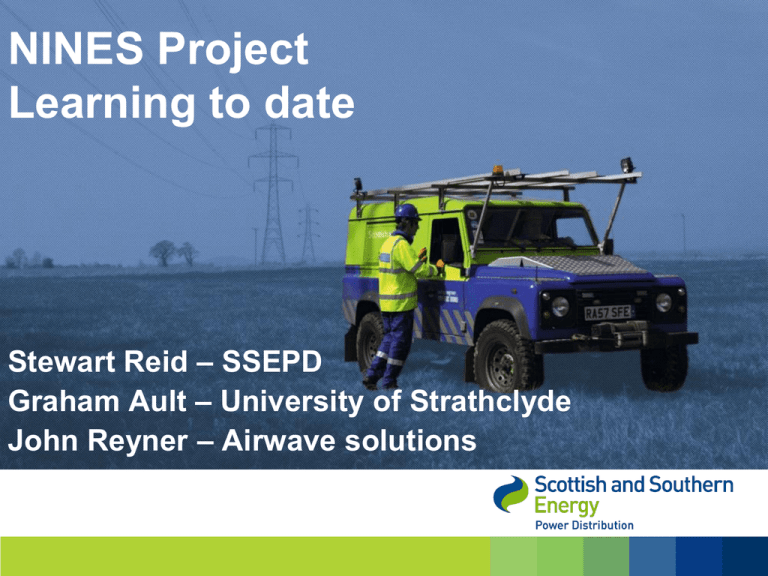
NINES Project Learning to date Stewart Reid – SSEPD Graham Ault – University of Strathclyde John Reyner – Airwave solutions NINES Overview 2 • No Mainland connection Single DC link £500M • Demand Max. 50MW-Min. 14MW • Renewables 4% by capacity 7% by Unit production l.f. ~50% • Population ~22,000 -2- NINES System Overview New Large Wind Existing Generation New Small Wind Lerwick Power Station LIC SVT Power Station Burradale Windfarm LIC Active Network Management System LIC LIC LIC Thermal Store DDSM 1MW Battery NINES Update New Large Wind Existing Generation New Small Wind Lerwick Power Station LIC SVT Power Station Burradale Windfarm LIC Active Network Management System LIC LIC LIC Thermal Store DDSM 1 MW Battery University of Strathclyde Modelling the Shetland Power System Shetland System Modelling: Overview Strategic Models Economic and commercial model Allocation of costs and benefits. Scheduling services enduring commercial arrangements Customer demand forecast model System development optimisation model Evaluated system development options Operating schedule and cost for given system configuration. Estimate of energy demands for operational period Operational Models Unit scheduling model Transient stability envelope for system operation Strategic and operational risk model Operational risks Dynamic system model Shetland System Modelling: Outcomes • Operational Models – Customer Demand: Quantification of flexible heat demand and thermal energy storage for domestic customers – Power System Dynamics: Envelope of stable/secure system operation – Unit Scheduling: Estimate of renewable energy access and role of flexible demand and energy storage • Strategic Models – Economic and Commercial: Private costs and benefits of Shetland repowering options and commercial arrangements concepts – Strategic Risk: Extensive mapping of Shetland low carbon smart grid risks and repowering investment decision tree – System Development: identification of future system development options and optimisation model specification Control Philosophy for the Active Network Management (ANM) Scheme Scheduling Engine Works ahead of real time based on forecasts and current system state Real Time Application of Schedule Applies schedules to flexible demand and battery storage Automatic RealTime Monitoring and Control Manages generation setpoint within constraints. Monitors energy delivery to flexible demand and monitors forecast error. Control Centre Manual Intervention Power system operators able to intervene in response to system conditions. Model Inputs to Operational System Homes with Heaters/Tank Monitored parameters Control Instructions Local Interface Controllers Load/storage state Controls and Schedules Domestic DSM ‘Element Manager’ Aggregate zone/group energy demand data Demand sampling requirements Controls and Schedules ANM System Resource status and forecasts Control Room / EMS / DMS Consumer classification Aggregation and scaling methods Customer Demand Model Energy forecast Unit Scheduling Model Required frequency response Schedule block sizes System stability constraints/rules Scheduling constraints/rules System Dynamic Model System stability constraints/rules Shetland System Dynamic Simulation: Transient frequency limits 2% underfrequency limit • Dynamic models of all system components in NINES: – Frequency responsive demand, thermal and renewable generation, energy storage • Identification of allowable/stable/secure system states through simulation System constraints on wind generation access • Identification of allowed ‘envelope’ for wind generation operation (forms input to scheduling model and operations) • Modification of ‘envelope’ dependent on de-risking NINES innovative solutions Unit Scheduling Model: Overview Demand and wind forecasts Stability Rules Network Rules Conventional Generation Smoothing Optimised energy schedule • Model configuration and setup: – Demand Model input: customer constraints – Dynamic Model input: stability/security constraints – System model, objectives and flexible demand and energy storage parameters • Uses Optimal Power Flow with linkage between time periods across scheduling horizon (e.g. 24 hours): – Applies constraints in priority order to generate schedule of energy flows to/from connected devices – Maximisation of low carbon generation Unit Scheduling Model: Energy Storage Domestic Space Heating: input from demand model 300.0 Demand for Heat (MW) 250.0 200.0 Current SOC 150.0 Target SOC 100.0 50.0 0.0 00:00 02:00 04:00 06:00 08:00 10:00 12:00 14:00 16:00 18:00 20:00 22:00 00:00 Time Domestic Hot Water: input from demand model 160.0 Demand for Heat (MW) 140.0 120.0 Current SOC 100.0 80.0 60.0 40.0 Target SOC 20.0 0.0 00:00 02:00 04:00 06:00 08:00 10:00 12:00 14:00 16:00 18:00 20:00 22:00 00:00 Time Battery Storage: flexible within scheduling process 1.5 1 ? 0.5 Current SOC 0 00:00 -0.5 -1 -1.5 02:00 04:00 06:00 08:00 10:00 12:00 14:00 16:00 18:00 20:00 22:00 00:00 Target SOC Scheduling Example: Stability Rules Fixed Demand 25 Power (MW) 20 15 10 5 0 00:00 02:00 04:00 06:00 08:00 10:00 Wind 14:00 16:00 18:00 20:00 22:00 00:00 16:00 18:00 20:00 22:00 00:00 Scheduled DDSM Power (MW) 10 12:00 5 0 00:00 02:00 04:00 06:00 08:00 10:00 12:00 14:00 • Starting with fixed component of demand and wind power forecast: schedule flexible demand (DDSM) within stability/security constraints • Domestic flexible heat demand scheduled into period of low fixed demand and high wind power output Scheduling Example: Network Rules Minimum Conventional Generation Current Scheduled Demand 25 Power (MW) 20 15 10 5 0 00:00 02:00 04:00 06:00 08:00 10:00 12:00 Scheduled 16:00 18:00 20:00 22:00 00:00 Curtailed Power (MW) 10 14:00 5 0 00:00 02:00 04:00 06:00 08:00 10:00 12:00 14:00 • With interim stage schedule: apply network constraint rules to achieve ‘network constrained schedule’ • Domestic heat demand rescheduled into periods when wind power would otherwise be constrained 16:00 18:00 20:00 22:00 00:00 Scheduling Example: Final Schedule and Actual Outcome Final Demand DDSM Demand Fixed Demand 25 Power (MW) 20 15 10 5 0 00:00 02:00 04:00 06:00 Actual Wind 08:00 10:00 12:00 Actual Conventional 14:00 Forecast Wind 16:00 18:00 20:00 22:00 00:00 22:00 00:00 Forecast Conventional 25 20 15 10 5 0 00:00 02:00 04:00 06:00 08:00 10:00 12:00 14:00 • Final schedule is subject to forecast error in delivery so ‘optimal’ schedule must be adjusted in real time • Acceptable deviations to conventional generation schedule 16:00 18:00 20:00 NINES Making the Connection Ross Macindoe Head of Future Networks Airwave Making the connection Power Sources Homes Advanced Energy Storage ANM • Inter-system Gateway • Devices group management • Aggregated data processing and feedback • Fast group-based comms • Integrated LIC and Communications Wider Long Term Benefits DDSM Outage Management Social Alarming Distributed Generation Airwave SmartWorld Telemonitoring Fault Monitoring Security and Alarming REAL PROGRESS = REAL LEARNING •THE KIT •THE PEOPLE •THE BUSINESS CASE ANM system Live Battery installed 6 home trial complete Customers validated benefits of Quantum Heaters Design for the customer not just for our “smart” aspirations NINES informing solutions elsewhere Detailed modelling and 6 homes confirming initial expected benefits Comms contract DSM/Storage portfolio management is essential THANK YOU
